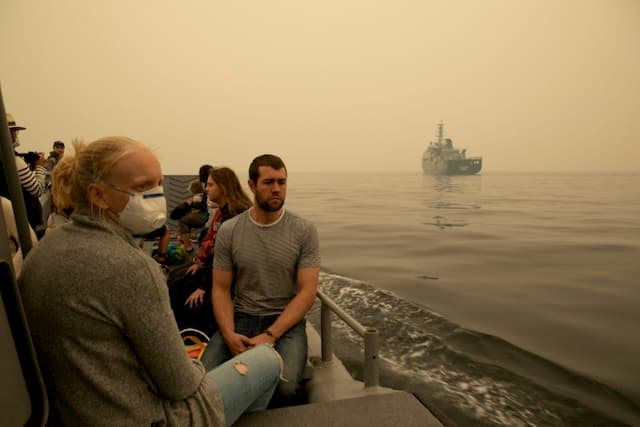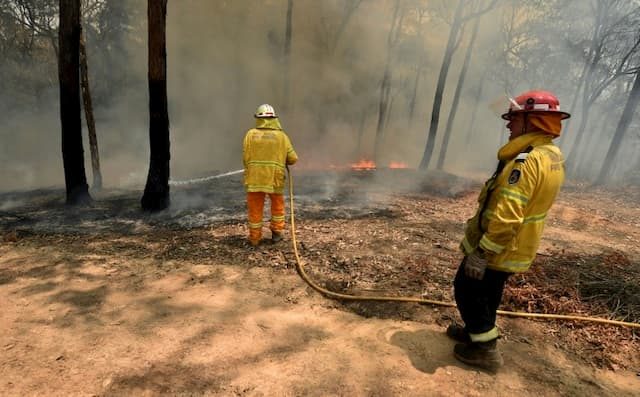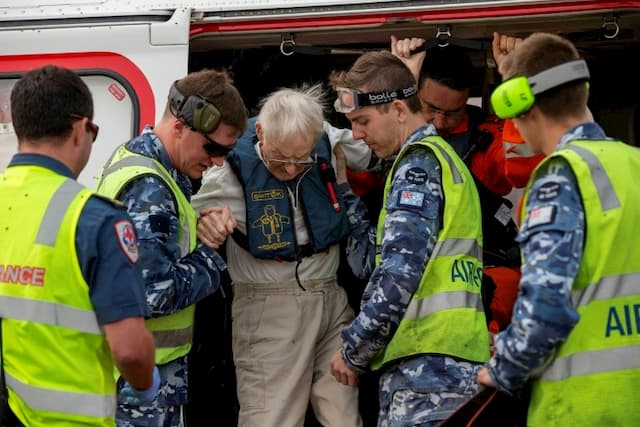Locals and tourists are fleeing New South Wales on Saturday 4th January 2020, as weather conditions threaten to further aggravate the devastating forest fires.
Tens of thousands of Australians were evacuated Saturday 4th January 2020 their homes to flee forest fires exacerbated by catastrophic weather conditions.
Temperatures exceeded 40 ° C on Saturday and strong winds were blowing, stoking hundreds of forest fires most of which are out of control .
“Compared to the forecasts (concerning the worst-case scenario) that we made this morning, unfortunately, they are coming true,” lamented Gladys Berejiklian, the Premier of New South Wales, during a press briefing.
“These strong winds and high temperatures” are expected to continue into the evening, said state fire chief Shane Fitzsimmons.
Sydney recorded record temperatures on Saturday, with 48.1 degrees recorded at Penrith in the western suburbs of Australia’s most populous city.
The temperature in Canberra reached 42.9 degrees, an unprecedented figure, said a spokesman for Australian weather services Jonathan How.
In these two cities, temperatures could rise further, he said.
Emergency state
Several warning messages were issued on Saturday across Australian territory. One of them concerns a fire southwest of Sydney which could reach the outskirts of the megalopolis.
A state of emergency was declared in the southeast of the island continent, the most populous region, and orders were given on Friday to more than 100,000 people to evacuate to three states.
“Today is about saving lives,” said Gladys Berejiklian.
“We have literally seen tens of thousands of people leave,” said New South Wales State fire chief Shane Fitzsimmons.
“Our message was to make sure you leave yesterday (Friday, note). To leave until today is to take a risk, to wait half an hour more is to take a greater risk. “
Tourists and inhabitants of the south-east of the country have thus abandoned their summer holiday resorts or their accommodation. The highways connecting the coastal cities to Sydney and other major cities were congested by long lines of cars.
Saturday promises to be “long” and difficult, according to Shane Fitzsimmons.

3000 military reservists deployed
The weather conditions should be Saturday “identical, even worse than what we saw on New Year’s Eve,” warned Jonathan How, of the Australian weather forecast. “Strong, dry westerly winds will reignite the ongoing fires,” “threatening populations that have already experienced widespread devastation,” he said.
Prime Minister Scott Morrison called on 3000 military reservists to deploy on Saturday, a mobilization his previous.
“This allows for more men on the ground, more planes in the sky, more ships at sea,” said Scott Morrison, criticized for his handling of the crisis.

Supermarkets, shops, closed pubs: a strange and disturbing calm reigned Saturday on Batemans Bay, a tourist town usually overflowing with activity, and today prey to the smoke of the surrounding fires.
The only sign of life in this locality, a reception centre for evacuees, where hundreds of residents forced to leave their homes have found refuge in tents and caravans, set up on city land.
It looks like “a refugee camp,” joked a resident Friday evening, settling there with her husband.
Mick Cummins, 57, and his wife fled to the evacuation centre when a fire ravaged their village on New Years Eve.
“We said to ourselves: it’s too hard for us, let’s go out. We went to the beach and hellish flames came up the hill, ”he told AFP.
“I was here during the 1994 fires. I thought it was hard. It was just a barbecue. “

23 dead
The scale of the fires in Australia shocked the country and the world.
Since the start of the fire season in September, 23 people have died , according to the Prime Minister.
Dozens of others are missing, more than 1,300 houses have been burnt to ashes. An area equivalent to twice Belgium burned.

The fires were also deadly for wildlife , and destroyed almost all of Flinders Chase National Park on Kangaroo Island, which is home to kangaroos and koalas, authorities said on Saturday.
In the small seaside town of Mallacoota, the Australian navy evacuated on Friday a thousand inhabitants and tourists surrounded by flames and some of whom had taken refuge on the seafront since New Year’s Eve to protect themselves.
The first of two military vessels chartered to rescue them arrived near Melbourne early Saturday.
Eloise Givney, 26, managed to flee under police escort when she and others had spent four days without electricity, telephone or internet.
“The flames approached up to 50 meters from us. We had to drive among them because it was the only way to leave, ”she told AFP, describing flames 15 meters high on both sides of the road. “We were stranded without power for four days. We had five children with us but no food for a day. “




